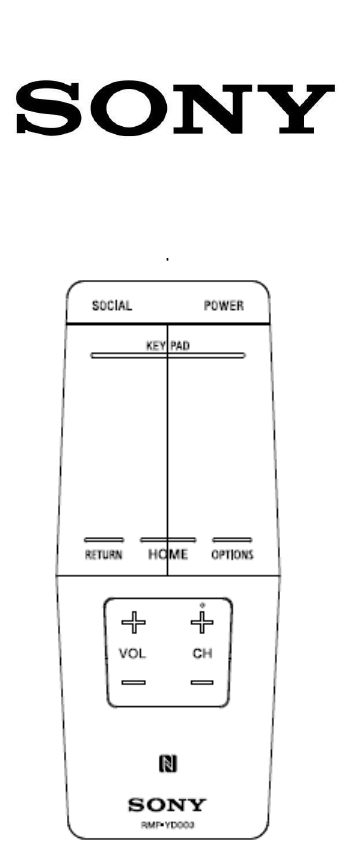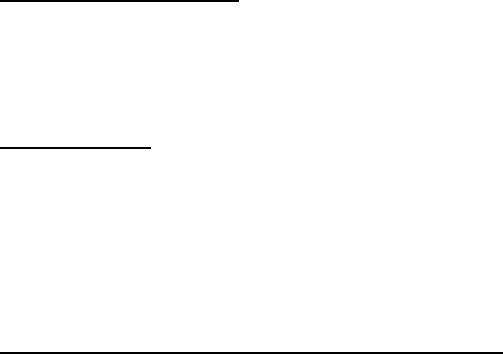Universal Electronics YD003 TV Remote Controller RMF-YD003 User Manual User Guide
Universal Electronics Inc TV Remote Controller RMF-YD003 User Guide
User Guide

Sony
Remote Control
Quick Reference Guide

CONTROLLING YOUR TV
1. Press Power key to turn on the TV.
2. Press any key other than power key to initiate pairing with TV.
3. All paring transaction is behind the scene and no setup is required.
Touchpad Area
1. Touch “keypad” area by finger and move it around to navigate GUI interactively
2. Pressing “keypad” area act as “Select” function
COMPLIANCE WITH FCC RULES AND REGULATIONS
This equipment has been tested and found to comply with the limits for a Class B digital device,
pursuant to part 15 of the FCC Rules. These limits are designed to provide reasonable protection
against harmful interference in a residential installation. This equipment generates, uses and can
radiate radio frequency energy and if not used in accordance with the instructions, may
cause harmful interference to radio communications.
However, there is no guarantee that interference will not occur in a particular installation. If this
equipment does cause harmful interference to radio or television reception, the user is
encouraged to try to correct the interference by one or more of the following measures:
• Increase or decrease the separation between the equipment and receiver.
Consult the dealer or an experienced remote control/ TV technician for help.
This equipment has been verified to comply with the limits for a
Class B computing device, pursuant to FCC Rules. The user is
cautioned that changes and modifications made to the equipment
without the approval of manufacturer could void the user's
authority to operate this equipment.
FCC Authorization Label
This device complies with part 15 of the FCC Rules. Operation is
subject to the following two conditions:
1. This device may not cause harmful interference.
2 This device must accept any interference received, including
interference that may cause undesired operation.
Under Industry Canada regulations, this radio transmitter may only operate using an antenna of a
type and maximum (or lesser) gain approved for the transmitter by Industry Canada.
To reduce potential radio interference to other users, the antenna type and its gain should be so
chosen that the equivalent isotropically radiated power (e.i.r.p.) is not more than that necessary
for successful communication.
This device complies with Industry Canada licence-exempt RSS standard(s). Operation is subject
to the following two conditions: (1) this device may not cause interference, and (2) this device
must accept any interference, including interference that may cause undesired operation of the
device.
Conformément à la réglementation d'Industrie Canada, le présent émetteur radio peut
fonctionner avec une antenne d'un type et d'un gain maximal (ou inférieur) approuvé pour
l'émetteur par Industrie Canada.
Dans le but de réduire les risques de brouillage radioélectrique à l'intention des autres
utilisateurs, il faut choisir le type d'antenne et son gain de sorte que la puissance isotrope
rayonnée équivalente (p.i.r.e.) ne dépasse pas l'intensité nécessaire à l'établissement d'une
communication satisfaisante.
Le présent appareil est conforme aux CNR d'Industrie Canada applicables aux appareils radio
exempts de licence. L'exploitation est autorisée aux deux conditions suivantes : (1) l'appareil ne
doit pas produire de brouillage, et (2) l'utilisateur de l'appareil doit accepter tout brouillage
radioélectrique subi, même si le brouillage est susceptible d'en compromettre le fonctionnement.
安全注意事項
根據 NCC 低功率電波輻射性電機管理辦法 規定:
第十二條
經型式認證合格之低功率射頻電機,非經許可,公司、商號或使用者均不得擅自變更頻率、加大功率或
變更原設計之特性及功能。
第十四條
低功率射頻電機之使用不得影響飛航安全及干擾合法通信;經發現有干擾現象時,應立即停用,並改善
至無干擾時方得繼續使用。
前項合法通信,指依電信法規定作業之無線電通信。
低功率射頻電機須忍受合法通信或工業、科學及醫療用電波輻射性電機設備之干擾。
‘La operación de este equipo está sujeta a las siguientes dos condiciones”
1. Es posible que este equipo o dispositivo no cause interferencia perjudicial
2. Este equipo o dispositivo debe aceptar cualquier interferencia. Incluyendo la que pueda
causar su operación no deseada.’
‘Este equipamento opera em caráter secundário, isto é, não tem direito a proteção contra
interferência prejudicial, mesmo de estações do mesmo tipo, e não pode causar interferência
a sistemas operando em caráter primário.’